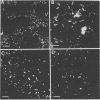Abstract
A major outbreak of 5,683 cases of pertussis occurred in northern Alberta, Canada, from December 1989 to January 1991. The outbreak highlighted a number of problems with current methods of pertussis diagnosis. In particular, an exceptionally high proportion of direct fluorescent-antibody (DFA)-positive, culture-negative specimens (88.4%) was identified. We took this opportunity to use polymerase chain reaction (PCR) methodology to examine whether the low culture rates were due to specimens containing dead organisms or whether the DFA results represented high numbers of false-positive results. A set of primer sequences within a Bordetella pertussis-specific repetitive element was used to amplify proteinase K extracts of B. pertussis DNA recovered from 279 submitted slides inoculated at the point of collection with nasopharyngeal material obtained from pernasal swabs. The PCR data corroborated the culture results: 84.6% of DFA-positive, culture-negative specimens were similarly PCR negative. At least three different bacterial species that were significantly cross-reactive with the commercial DFA reagent were identified in clinical specimens and in pure culture, providing one possible explanation for the false-positive DFA results. These results and other limitations of current diagnostic techniques underline the urgent need for a new DFA reagent with improved specificity and a standardized means of measuring the patient antibody response for the diagnosis of pertussis.
Full text
PDF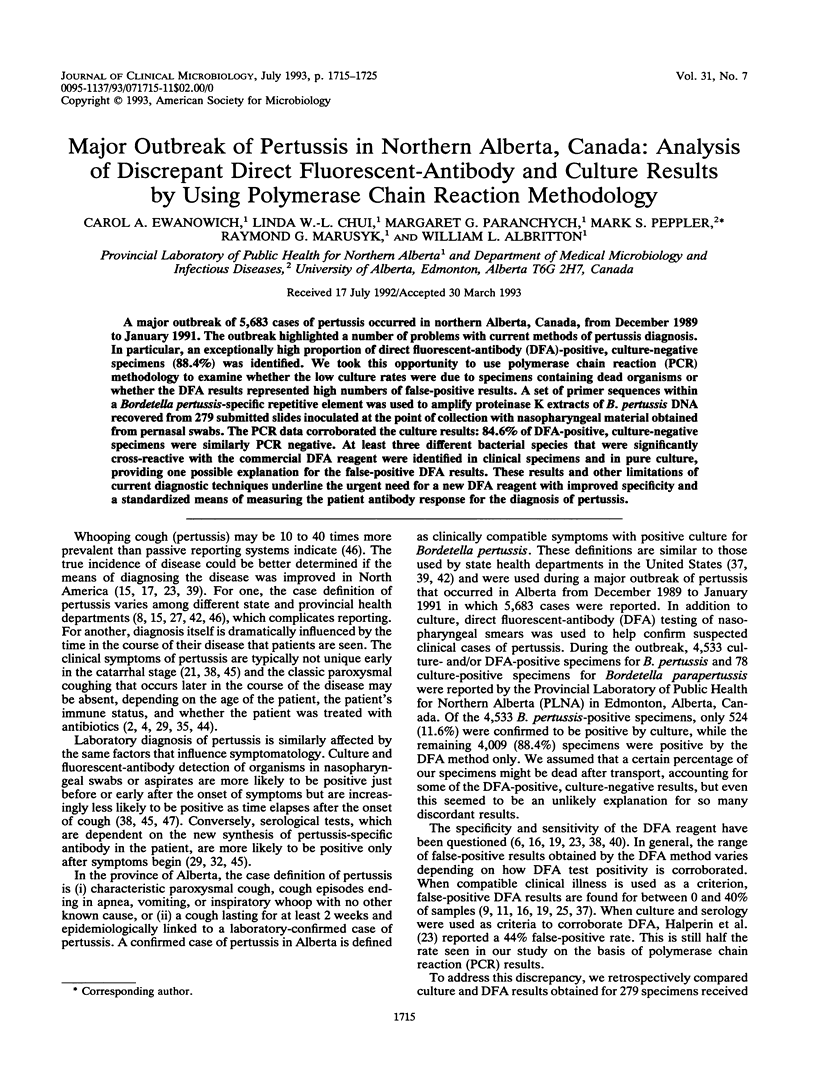
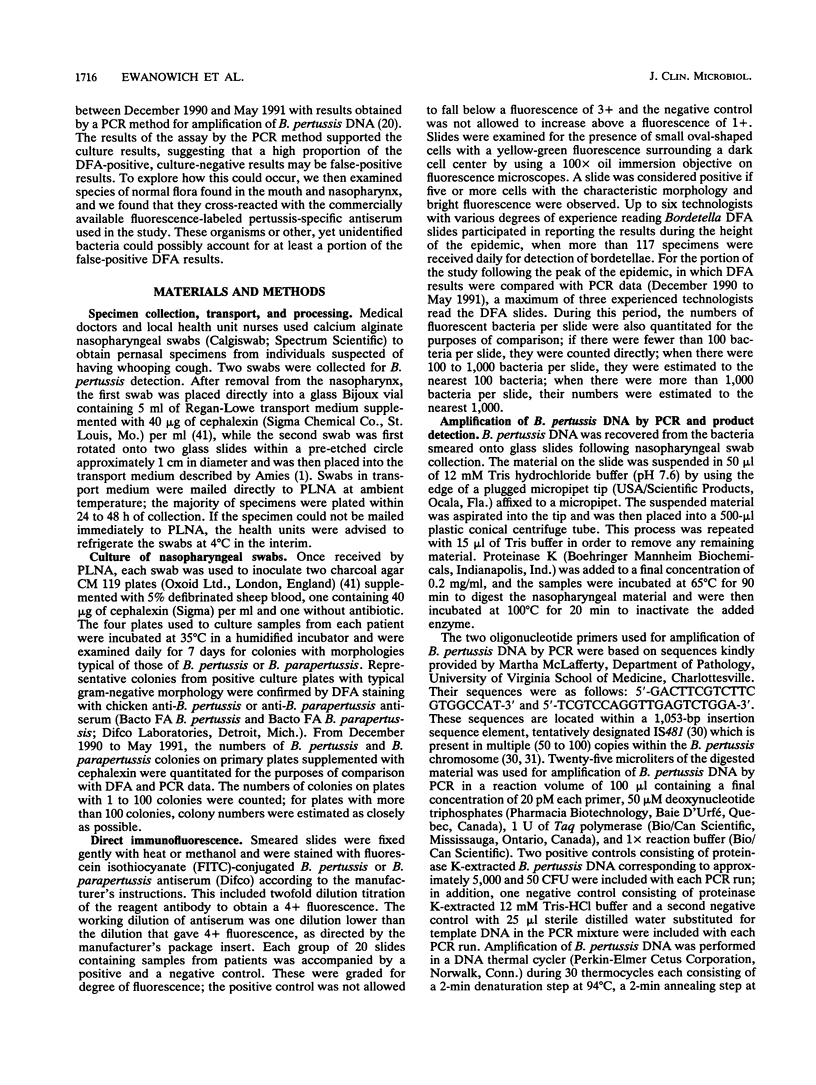
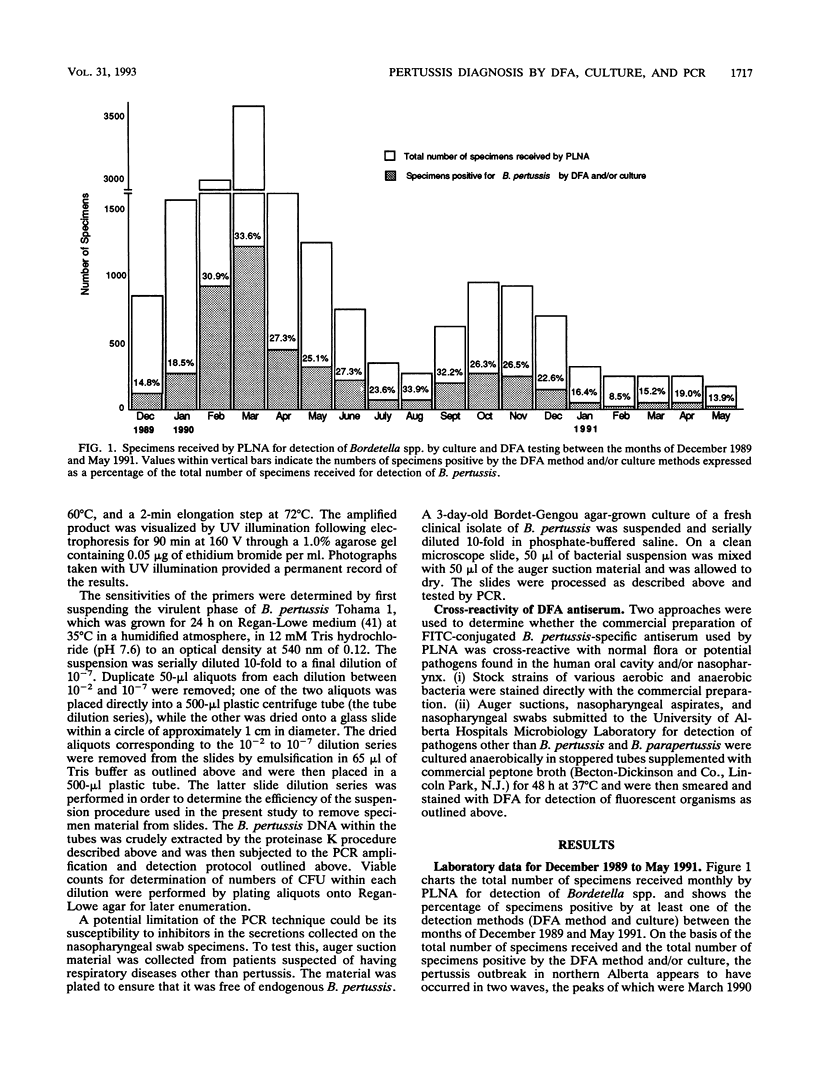
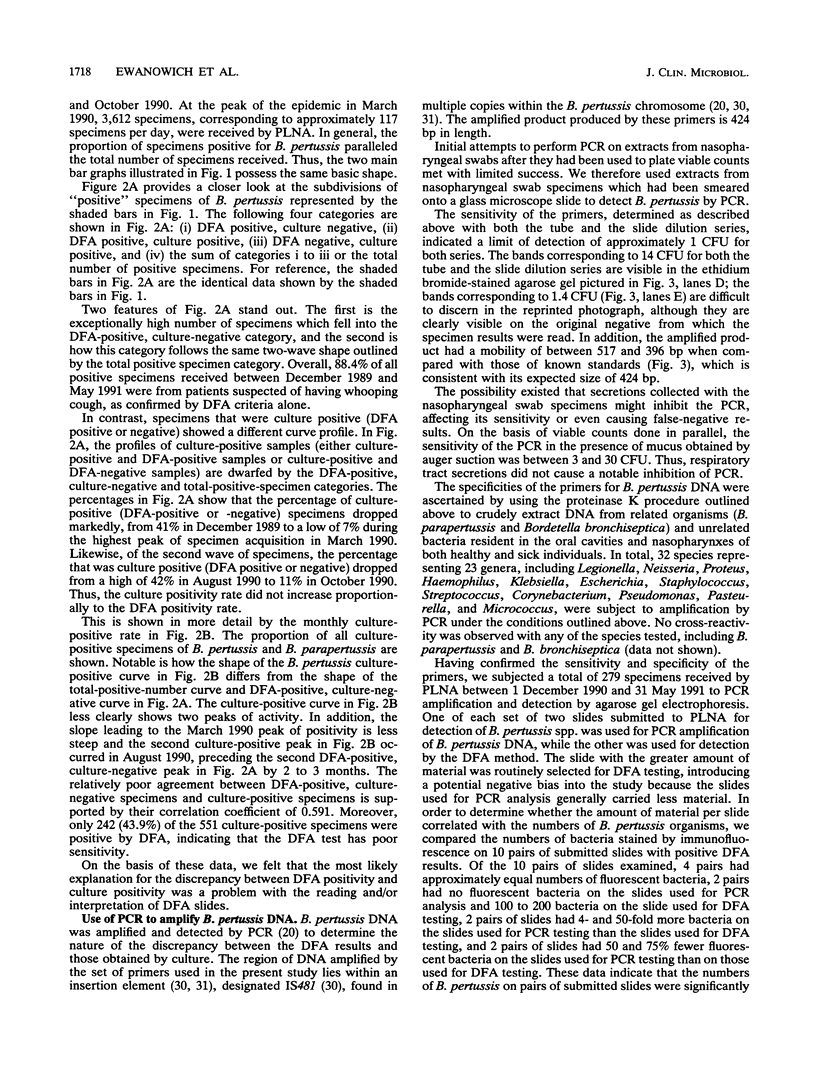
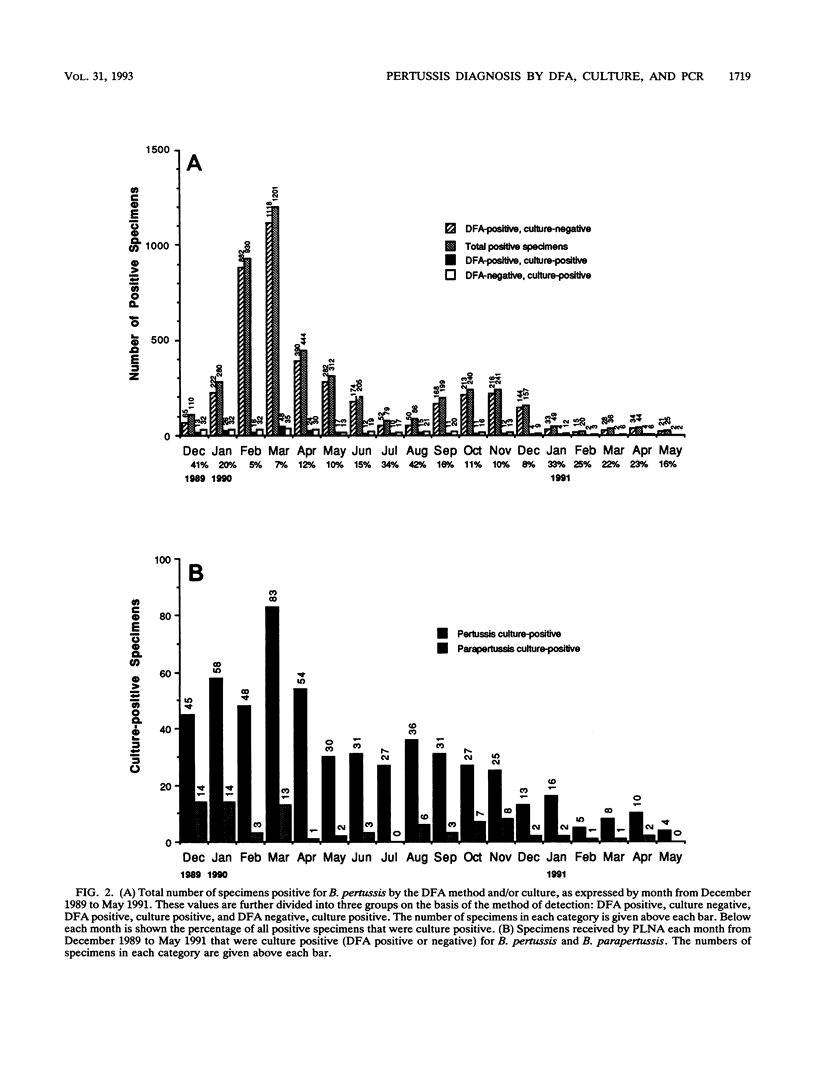
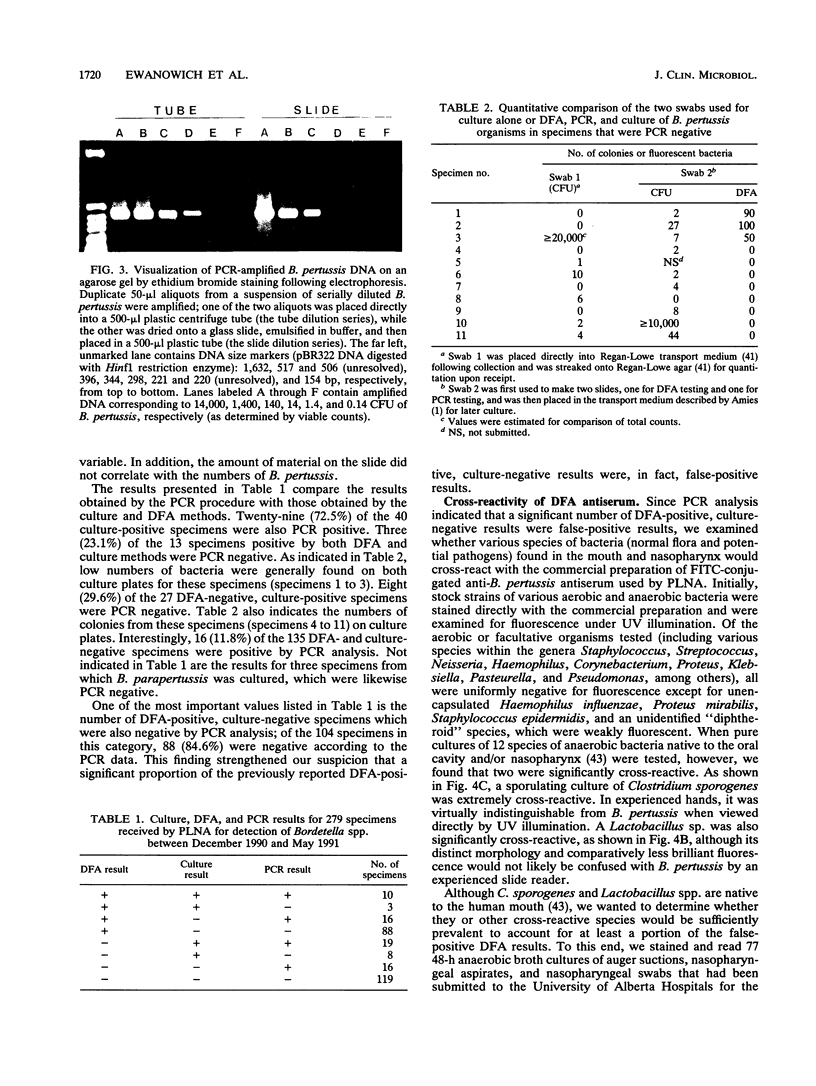
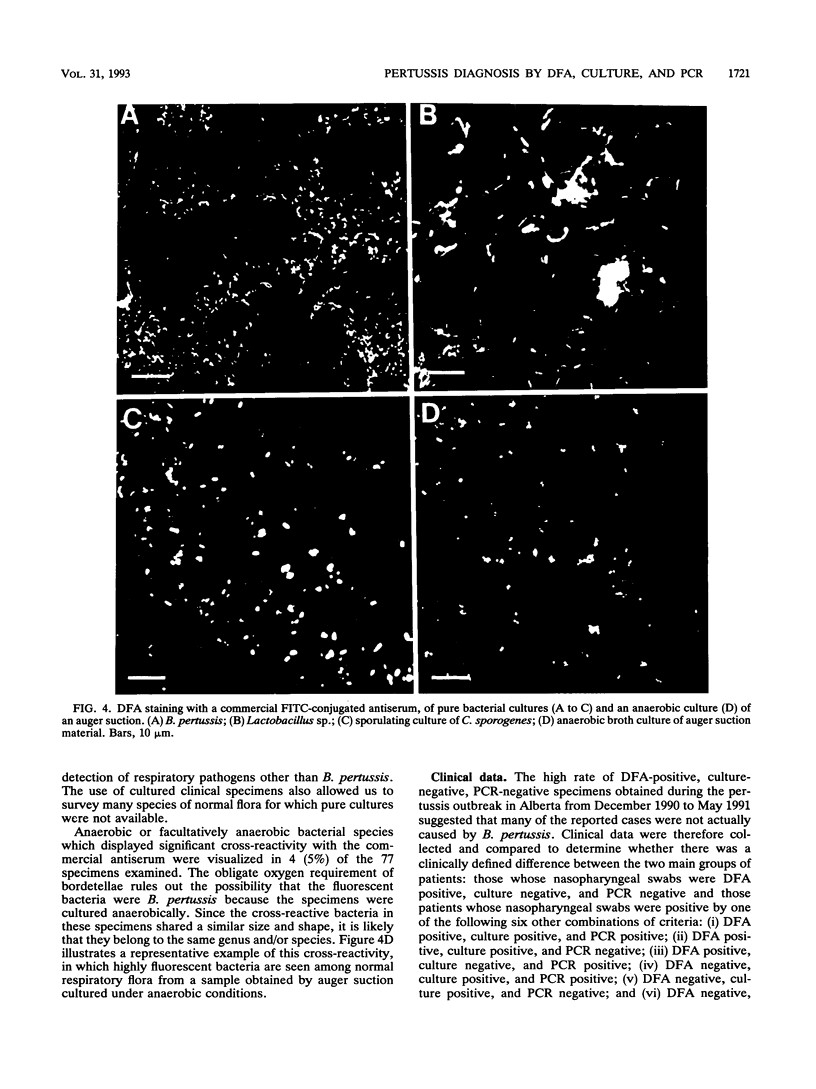
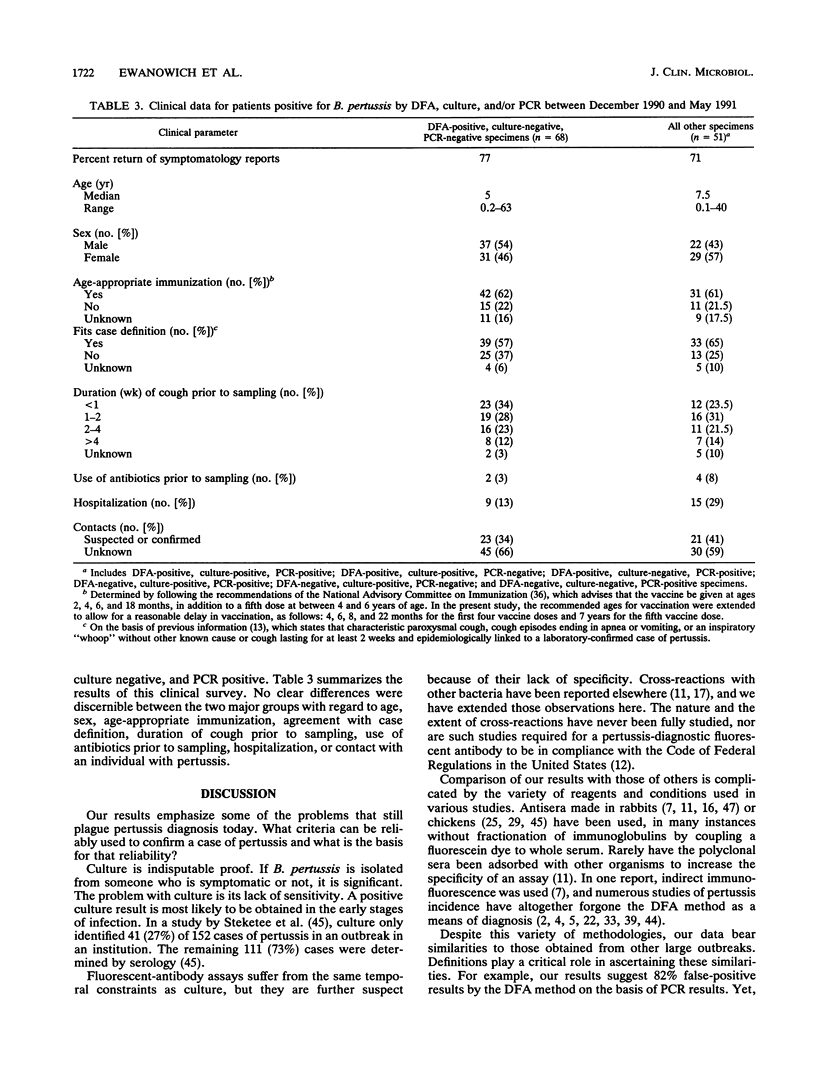
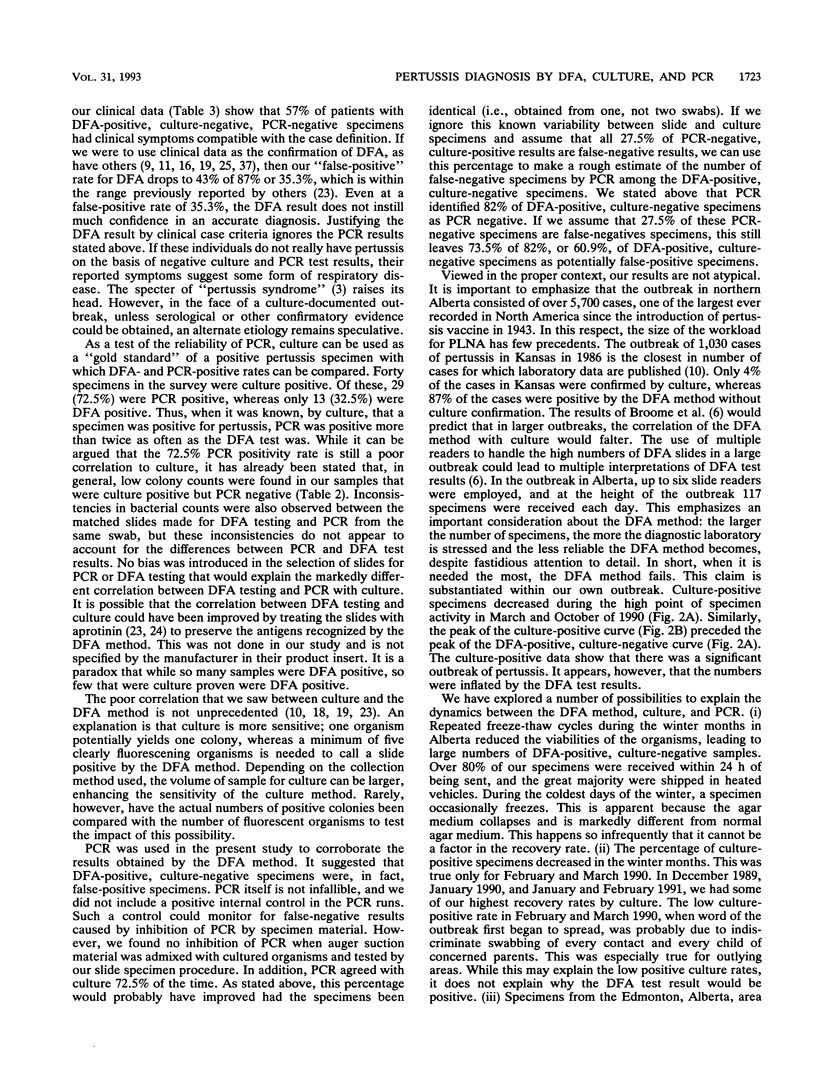

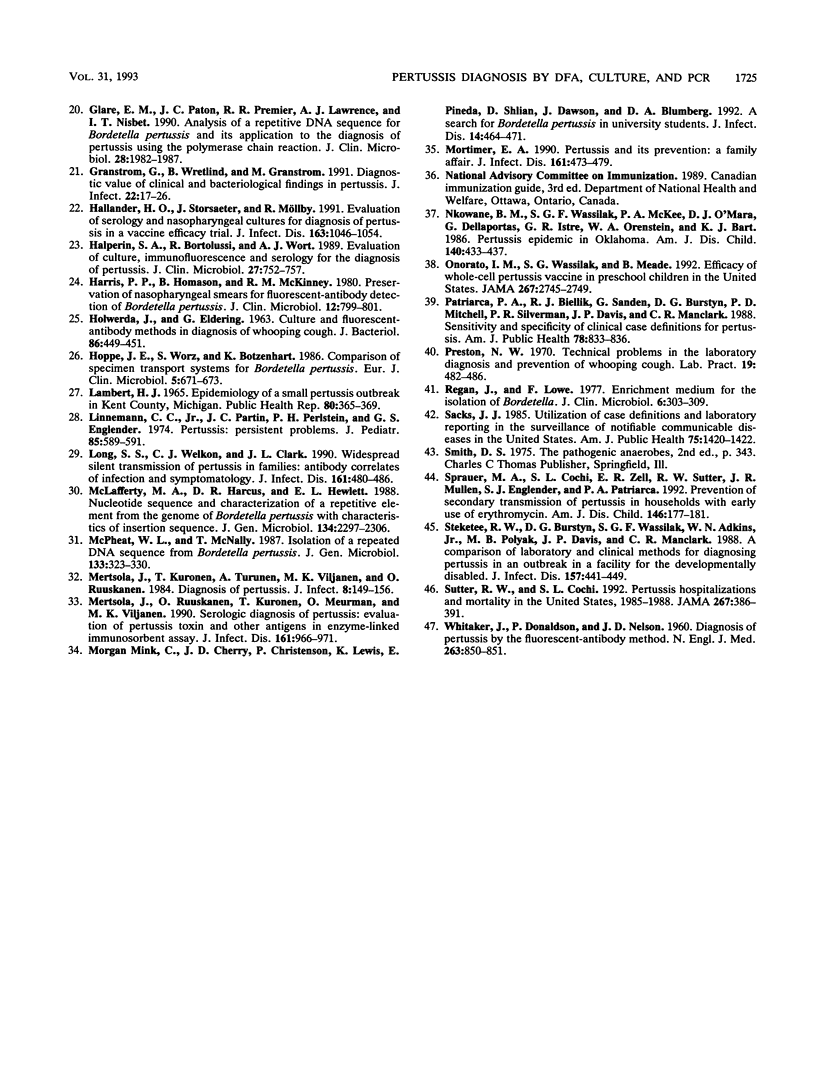
Images in this article
Selected References
These references are in PubMed. This may not be the complete list of references from this article.
- Amies C. R. A modified formula for the preparation of Stuart's Transport Medium. Can J Public Health. 1967 Jul;58(7):296–300. [PubMed] [Google Scholar]
- Aoyama T., Takeuchi Y., Goto A., Iwai H., Murase Y., Iwata T. Pertussis in adults. Am J Dis Child. 1992 Feb;146(2):163–166. doi: 10.1001/archpedi.1992.02160140029015. [DOI] [PubMed] [Google Scholar]
- Baraff L. J., Wilkins J., Wehrle P. F. The role of antibiotics, immunizations, and adenoviruses in pertussis. Pediatrics. 1978 Feb;61(2):224–230. [PubMed] [Google Scholar]
- Biellik R. J., Patriarca P. A., Mullen J. R., Rovira E. Z., Brink E. W., Mitchell P., Hamilton G. H., Sullivan B. J., Davis J. P. Risk factors for community- and household-acquired pertussis during a large-scale outbreak in central Wisconsin. J Infect Dis. 1988 Jun;157(6):1134–1141. doi: 10.1093/infdis/157.6.1134. [DOI] [PubMed] [Google Scholar]
- Blackwelder W. C., Storsaeter J., Olin P., Hallander H. O. Acellular pertussis vaccines. Efficacy and evaluation of clinical case definitions. Am J Dis Child. 1991 Nov;145(11):1285–1289. doi: 10.1001/archpedi.1991.02160110077024. [DOI] [PubMed] [Google Scholar]
- Campbell P. B., Masters P. L., Rohwedder E. Whooping cough diagnosis: a clinical evaluation of complementing culture and immunofluorescence with enzyme-linked immunosorbent assay of pertussis immunoglobulin A in nasopharyngeal secretions. J Med Microbiol. 1988 Dec;27(4):247–254. doi: 10.1099/00222615-27-4-247. [DOI] [PubMed] [Google Scholar]
- Chalvardjian N. The laboratory diagnosis of whooping cough by fluorescent antibody and by culture methods. Can Med Assoc J. 1966 Aug 6;95(6):263–266. [PMC free article] [PubMed] [Google Scholar]
- DONALDSON P., WHITAKER J. A. Diagnosis of pertussis by fluorescent antibody staining of nasopharyngeal smears. AMA J Dis Child. 1960 Apr;99:423–427. doi: 10.1001/archpedi.1960.02070030425004. [DOI] [PubMed] [Google Scholar]
- Farizo K. M., Cochi S. L., Zell E. R., Brink E. W., Wassilak S. G., Patriarca P. A. Epidemiological features of pertussis in the United States, 1980-1989. Clin Infect Dis. 1992 Mar;14(3):708–719. doi: 10.1093/clinids/14.3.708. [DOI] [PubMed] [Google Scholar]
- Field L. H., Parker C. D. Pertussis outbreak in Austin and Travis County, Texas, 1975. J Clin Microbiol. 1977 Aug;6(2):154–160. doi: 10.1128/jcm.6.2.154-160.1977. [DOI] [PMC free article] [PubMed] [Google Scholar]
- Friedman R. L. Pertussis: the disease and new diagnostic methods. Clin Microbiol Rev. 1988 Oct;1(4):365–376. doi: 10.1128/cmr.1.4.365. [DOI] [PMC free article] [PubMed] [Google Scholar]
- Gan V. N., Murphy T. V. Pertussis in hospitalized children. Am J Dis Child. 1990 Oct;144(10):1130–1134. doi: 10.1001/archpedi.1990.02150340076027. [DOI] [PubMed] [Google Scholar]
- Gilligan P. H., Fisher M. C. Importance of culture in laboratory diagnosis of Bordetella pertussis infections. J Clin Microbiol. 1984 Nov;20(5):891–893. doi: 10.1128/jcm.20.5.891-893.1984. [DOI] [PMC free article] [PubMed] [Google Scholar]
- Glare E. M., Paton J. C., Premier R. R., Lawrence A. J., Nisbet I. T. Analysis of a repetitive DNA sequence from Bordetella pertussis and its application to the diagnosis of pertussis using the polymerase chain reaction. J Clin Microbiol. 1990 Sep;28(9):1982–1987. doi: 10.1128/jcm.28.9.1982-1987.1990. [DOI] [PMC free article] [PubMed] [Google Scholar]
- Granström G., Wretlind B., Granström M. Diagnostic value of clinical and bacteriological findings in pertussis. J Infect. 1991 Jan;22(1):17–26. doi: 10.1016/0163-4453(91)90842-g. [DOI] [PubMed] [Google Scholar]
- HOLWERDA J., ELDERING G. CULTURE AND FLUORESCENT-ANTIBODY METHODS IN DIAGNOSIS OF WHOOPING COUGH. J Bacteriol. 1963 Sep;86:449–451. doi: 10.1128/jb.86.3.449-451.1963. [DOI] [PMC free article] [PubMed] [Google Scholar]
- Hallander H. O., Storsaeter J., Möllby R. Evaluation of serology and nasopharyngeal cultures for diagnosis of pertussis in a vaccine efficacy trial. J Infect Dis. 1991 May;163(5):1046–1054. doi: 10.1093/infdis/163.5.1046. [DOI] [PubMed] [Google Scholar]
- Halperin S. A., Bortolussi R., Wort A. J. Evaluation of culture, immunofluorescence, and serology for the diagnosis of pertussis. J Clin Microbiol. 1989 Apr;27(4):752–757. doi: 10.1128/jcm.27.4.752-757.1989. [DOI] [PMC free article] [PubMed] [Google Scholar]
- Harris P. P., Thomason B., McKinney R. M. Preservation of nasopharyngeal smears for fluorescent antibody detection of Bordetella pertussis. J Clin Microbiol. 1980 Dec;12(6):799–801. doi: 10.1128/jcm.12.6.799-801.1980. [DOI] [PMC free article] [PubMed] [Google Scholar]
- Hoppe J. E., Wörz S., Botzenhart K. Comparison of specimen transport systems for Bordetella pertussis. Eur J Clin Microbiol. 1986 Dec;5(6):671–673. doi: 10.1007/BF02013299. [DOI] [PubMed] [Google Scholar]
- LAMBERT H. J. EPIDEMIOLOGY OF A SMALL PERTUSSIS OUTBREAK IN KENT COUNTY, MICHIGAN. Public Health Rep. 1965 Apr;80:365–369. [PMC free article] [PubMed] [Google Scholar]
- Linnemann C. C., Jr, Partin J. C., Perlstein P. H., Englender G. S. Pertussis: persistent problems. J Pediatr. 1974 Oct;85(4):589–591. doi: 10.1016/s0022-3476(74)80496-8. [DOI] [PubMed] [Google Scholar]
- Long S. S., Welkon C. J., Clark J. L. Widespread silent transmission of pertussis in families: antibody correlates of infection and symptomatology. J Infect Dis. 1990 Mar;161(3):480–486. doi: 10.1093/infdis/161.3.480. [DOI] [PubMed] [Google Scholar]
- McLafferty M. A., Harcus D. R., Hewlett E. L. Nucleotide sequence and characterization of a repetitive DNA element from the genome of Bordetella pertussis with characteristics of an insertion sequence. J Gen Microbiol. 1988 Aug;134(8):2297–2306. doi: 10.1099/00221287-134-8-2297. [DOI] [PubMed] [Google Scholar]
- McPheat W. L., McNally T. Isolation of a repeated DNA sequence from Bordetella pertussis. J Gen Microbiol. 1987 Feb;133(2):323–330. doi: 10.1099/00221287-133-2-323. [DOI] [PubMed] [Google Scholar]
- Mertsola J., Kuronen T., Turunen A., Viljanen M. K., Ruuskanen O. Diagnosis of pertussis. J Infect. 1984 Mar;8(2):149–156. doi: 10.1016/s0163-4453(84)92559-3. [DOI] [PubMed] [Google Scholar]
- Mertsola J., Ruuskanen O., Kuronen T., Meurman O., Viljanen M. K. Serologic diagnosis of pertussis: evaluation of pertussis toxin and other antigens in enzyme-linked immunosorbent assay. J Infect Dis. 1990 May;161(5):966–971. doi: 10.1093/infdis/161.5.966. [DOI] [PubMed] [Google Scholar]
- Mink C. M., Cherry J. D., Christenson P., Lewis K., Pineda E., Shlian D., Dawson J. A., Blumberg D. A. A search for Bordetella pertussis infection in university students. Clin Infect Dis. 1992 Feb;14(2):464–471. doi: 10.1093/clinids/14.2.464. [DOI] [PubMed] [Google Scholar]
- Mortimer E. A., Jr Pertussis and its prevention: a family affair. J Infect Dis. 1990 Mar;161(3):473–479. doi: 10.1093/infdis/161.3.473. [DOI] [PubMed] [Google Scholar]
- Nkowane B. M., Wassilak S. G., McKee P. A., O'Mara D. J., Dellaportas G., Istre G. R., Orenstein W. A., Bart K. J. Pertussis epidemic in Oklahoma. Difficulties in preventing transmission. Am J Dis Child. 1986 May;140(5):433–437. doi: 10.1001/archpedi.1986.02140190043021. [DOI] [PubMed] [Google Scholar]
- Onorato I. M., Wassilak S. G., Meade B. Efficacy of whole-cell pertussis vaccine in preschool children in the United States. JAMA. 1992 May 27;267(20):2745–2749. [PubMed] [Google Scholar]
- Patriarca P. A., Biellik R. J., Sanden G., Burstyn D. G., Mitchell P. D., Silverman P. R., Davis J. P., Manclark C. R. Sensitivity and specificity of clinical case definitions for pertussis. Am J Public Health. 1988 Jul;78(7):833–836. doi: 10.2105/ajph.78.7.833. [DOI] [PMC free article] [PubMed] [Google Scholar]
- Preston N. W. Technical problems in the laboratory diagnosis and prevention of whooping-cough. Lab Pract. 1970 May;19(5):482–486. [PubMed] [Google Scholar]
- Regan J., Lowe F. Enrichment medium for the isolation of Bordetella. J Clin Microbiol. 1977 Sep;6(3):303–309. doi: 10.1128/jcm.6.3.303-309.1977. [DOI] [PMC free article] [PubMed] [Google Scholar]
- Sacks J. J. Utilization of case definitions and laboratory reporting in the surveillance of notifiable communicable diseases in the United States. Am J Public Health. 1985 Dec;75(12):1420–1422. doi: 10.2105/ajph.75.12.1420. [DOI] [PMC free article] [PubMed] [Google Scholar]
- Sprauer M. A., Cochi S. L., Zell E. R., Sutter R. W., Mullen J. R., Englender S. J., Patriarca P. A. Prevention of secondary transmission of pertussis in households with early use of erythromycin. Am J Dis Child. 1992 Feb;146(2):177–181. doi: 10.1001/archpedi.1992.02160140043018. [DOI] [PubMed] [Google Scholar]
- Steketee R. W., Burstyn D. G., Wassilak S. G., Adkins W. N., Jr, Polyak M. B., Davis J. P., Manclark C. R. A comparison of laboratory and clinical methods for diagnosing pertussis in an outbreak in a facility for the developmentally disabled. J Infect Dis. 1988 Mar;157(3):441–449. doi: 10.1093/infdis/157.3.441. [DOI] [PubMed] [Google Scholar]
- Sutter R. W., Cochi S. L. Pertussis hospitalizations and mortality in the United States, 1985-1988. Evaluation of the completeness of national reporting. JAMA. 1992 Jan 15;267(3):386–391. [PubMed] [Google Scholar]
- WHITAKER J. A., DONALDSON P., NELSON J. D. Diagnosis of pertussis by the fluorescent-antibody method. N Engl J Med. 1960 Oct 27;263:850–851. doi: 10.1056/NEJM196010272631708. [DOI] [PubMed] [Google Scholar]




